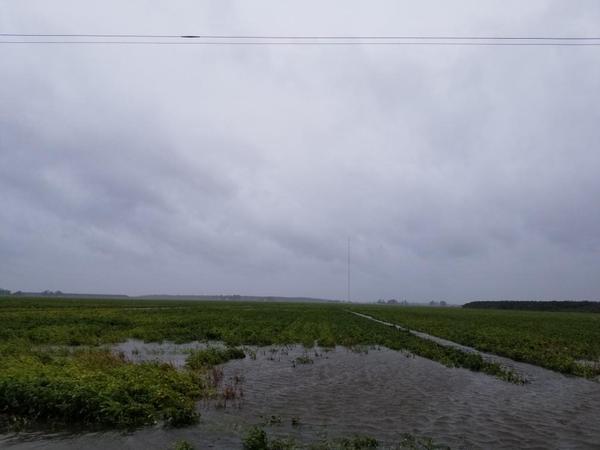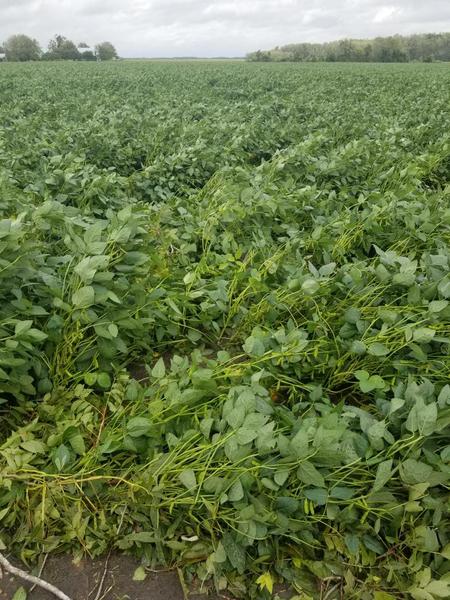Introduction
Hurricane damage to soybeans is unfortunately often encountered from August through October in North Carolina as soybeans move into later developmental stages. Degree of damage will depend on various factors including soybean growth stage, length of time fields are flooded, wind speed, and subsequent weather events. Soybeans at all growth stages can be negatively impacted by hurricane-related damage. Certain stressors can be worse at earlier soybean growth stages or later soybean growth stages. Earlier maturing varieties are likely to be impacted by delayed harvest, premature sprouting, and potential shattering. Later maturing varieties may be impacted by inhibited seed development, disease pressure, and reduced quality.
Symptoms
Soybeans that have been under flooded conditions for several days have an increased risk of being contaminated by things such as mycotoxins and diseases. Excessive rainfall can cause pod splitting. This is especially problematic if the excessive rainfall followed a dry spell. When soybeans are at R6 (full seed) or R7 (physiological maturity) and receive excessive rainfall, rapid seed growth can cause pod splitting, especially when pods are small due to earlier season stressors. Premature seed sprouting is generally rare but can be an issue when the moisture of the seed drops below 50%, and then goes back above 50%.
Soybean lodging can be caused by strong winds and by water flow across the field. The effect of lodging on soybean yield is variable, but soybeans in the beginning seed stage (R5) will likely be more prone to damage from lodging than soybeans that are further into physiological development. There are two types of yield losses associated with lodging including restriction of maximum physiological development and harvest loss. Restriction of maximum physiological development can occur from lodging reducing photosynthesis in the upper, more productive leaves. Harvest loss from lodging can range from 3-10% (Holshouser, 2015).
Shattering is intensified when dry pods are rehydrated by excessive moisture followed again by a dry period. Shattering losses can be more severe with earlier maturing varieties that are close to physiological maturity and are ready for harvest. Delayed harvest can intensify shattering.
Management
Follow recommended seeding rates for your location and planting date. Too high of a seeding rate will reduce stem size and increase the potential for above-ground lodging. Non-uniform seed spacing also increases lodging potential, so ensure uniform seed spacing in the row. (Planting with standard drills (non-uniform placement) usually results in more lodging.)
Disease can be worsened by periods of flooding, significant rainfall, and damages from wind, hard rain, or hail. Select soybean varieties with robust disease resistance, especially during La Niña years when hurricanes are likely to be more abundant. The North Carolina Soybean Variety Selection tool can be used to filter for varieties with robust disease resistance packages. In periods of extended flooding, root rots caused by Phytophthora sojae or Pythium spp. or other fungal pathogens like Fusarium spp. may cause significant losses in soybeans. The yield and quality of soybeans can also be threatened following hurricanes by foliar diseases—including frogeye leaf spot, Cercospora blight, rust, and bacterial blight—due to prolonged exposure to high moisture and high temperature. If conditions are likely conducive for disease development, you can proactively spray fungicides to help prevent disease proliferation.
When safe, closely inspect fields where flooding has occurred. Three to four days of continuous flooding can cause irreversible damage in soybean and subsequent yield declines. In addition to agronomic damage, flooded grain could be considered altered by your insurance company depending on flooded water source. Completely submerged pods have the potential for toxin contamination and some insurance policies may allow for zero appraisal following this situation. This situation may require entry into nontraditional markets if grain is determined sellable.
Devise an alternative storage plan for damaged soybeans. If you have a diversity of soybean maturity groups and varieties planted on your farm, chances are you will have differing levels of soybean damage among your fields. Field to field damage will also vary depending on proximity to flooded water sources. If possible damaged grain should be stored separately for undamaged or minimally damaged grain to ensure high-quality grain can be sold without dockage.
Additional Resources
Holshouser, D. 2011. The Good and Bad of a Wet September. Virginia Tech University Cooperative Extension.
Holshouser, D. 2015. Lodging and It’s Effect on Soybean Yield. Virginia Tech University Cooperative Extension.
Hurricane Preparedness – Considerations for Soybeans (NC State Extension)
Soybean Considerations Following Hurricane Florence (NC State Extension)
Publication date: June 2, 2020
N.C. Cooperative Extension prohibits discrimination and harassment regardless of age, color, disability, family and marital status, gender identity, national origin, political beliefs, race, religion, sex (including pregnancy), sexual orientation and veteran status.
NC Cooperative Extension prohíbe la discriminación por raza, color, nacionalidad, edad, sexo (incluyendo el embarazo), discapacidad, religión, orientación sexual, identidad de género, información genética, afiliación política, y estatus de veteran.
The use of brand names in this publication does not imply endorsement by NC State University or N.C. A&T State University of the products or services named nor discrimination against similar products or services not mentioned.
Recommendations for the use of agricultural chemicals are included in this publication as a convenience to the reader. The use of brand names and any mention or listing of commercial products or services in this publication does not imply endorsement by NC State University or N.C. A&T State University nor discrimination against similar products or services not mentioned. Individuals who use agricultural chemicals are responsible for ensuring that the intended use complies with current regulations and conforms to the product label. Be sure to obtain current information about usage regulations and examine a current product label before applying any chemical. For assistance, contact your local N.C. Cooperative Extension county center.
N.C. Cooperative Extension prohibits discrimination and harassment regardless of age, color, disability, family and marital status, gender identity, national origin, political beliefs, race, religion, sex (including pregnancy), sexual orientation and veteran status.


